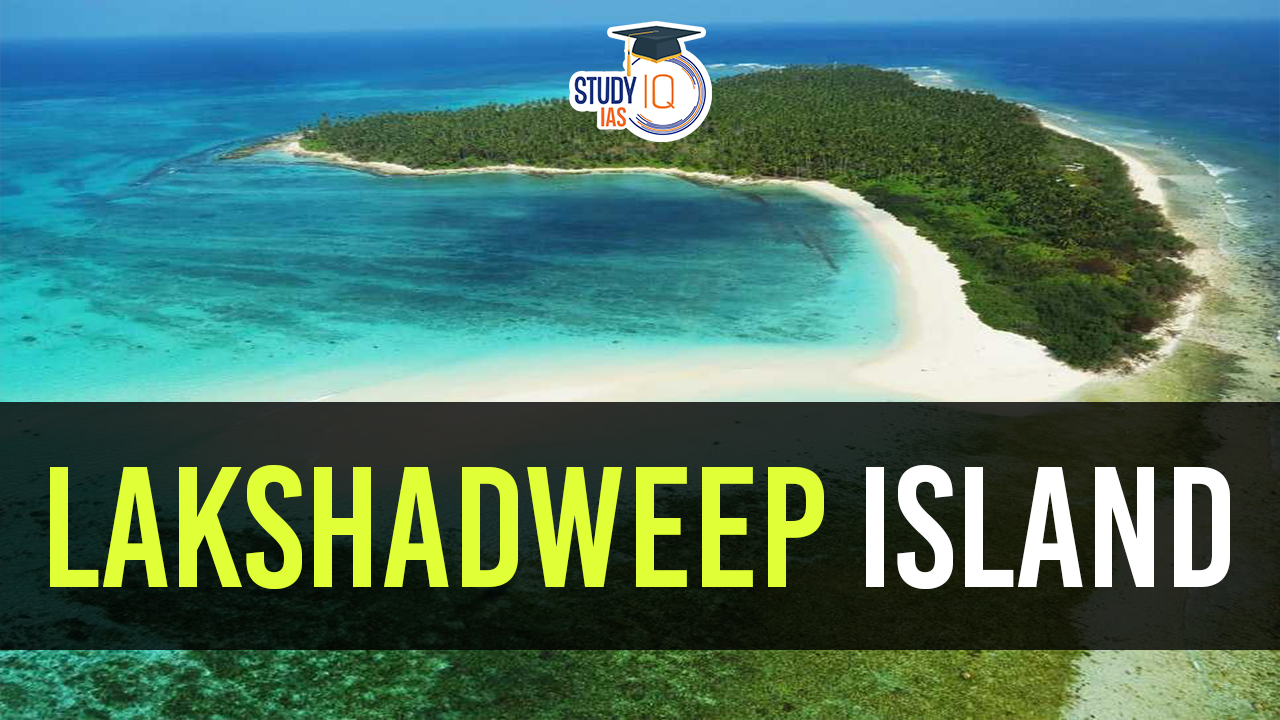Table of Contents
Prime Minister Narendra Modi’s recent visit to Lakshadweep Island underscores strategic significance amid growing Chinese engagement in neighboring countries. With a focus on strong borders, PM Modi inaugurated projects worth Rs 1,150 crore, emphasizing development initiatives in border areas. Know all about Lakshadweep Island in this article.
We’re now on WhatsApp. Click to Join
Lakshadweep Island
Renowned for its exotic, sun-kissed beaches, and vibrant green landscapes, Lakshadweep is a group of 36 islands that beckon with natural splendor. In Malayalam and Sanskrit, the name Lakshadweep translates to ‘a hundred thousand islands,’ reflecting the archipelago’s rich and diverse environment.
Lakshadweep Island, India’s smallest Union Territory, unfolds as an enchanting archipelago sprawled across 32 square kilometers. This uni-district Union Territory boasts 12 atolls, three reefs, five submerged banks, and ten inhabited islands. The capital, Kavaratti, not only serves as the administrative center but also stands as the principal town of this picturesque Union Territory.
| Details | |
|---|---|
| Location | Arabian Sea, off the southwest coast of India |
| Number of Islands | 36 (10 inhabited) |
| Capital | Kavaratti |
| Area | 32 sq km |
| Population | Approximately 73,000 (as of my last knowledge update in 2022) |
| Official Language | Malayalam |
| Administrative Setup | Union Territory of India |
| Economy | Primarily dependent on fisheries and tourism |
| Geography | Coral atolls, lagoons, and pristine beaches |
| Climate | Tropical, with a monsoon climate |
| Biodiversity | Rich marine life, coral reefs, and diverse flora and fauna |
| Transportation | Limited air and sea connectivity; helicopters and ships are common modes of transportation |
| Tourist Attractions | Beautiful beaches, coral reefs, and water sports; Marine biodiversity is a major draw |
| Cuisine | Seafood is a staple; coconut-based dishes are popular |
| Culture | Influenced by Arab, Portuguese, and Indian traditions; Festivals and dance forms are integral to the culture |
| Notable Islands | Kavaratti, Agatti, Bangaram, Minicoy |
| Unique Features | Controlled tourism to preserve the delicate ecosystem; Ban on alcohol consumption for locals |
Geography of Lakshadweep
- Location: Lakshadweep is located about 200 to 400 kilometers off the coast of the southwestern Indian state of Kerala.
- Islands: The union territory consists of 36 islands, including 12 atolls, 3 reefs, and 5 submerged banks. The major islands are Kavaratti, Agatti, Minicoy, Amini, Kalpeni, Kadmat, and Andrott.
- Geographical Formation: Lakshadweep is a coral archipelago formed by coral reefs, atolls, and submerged banks. The islands are built on ancient volcanic rocks.
Lakshadweep Administration
- Union Territory: Lakshadweep became a union territory of India in 1956. It is governed by an Administrator appointed by the President of India.
- Capital: The capital of Lakshadweep is Kavaratti.
Culture of Lakshadweep
- Population: The population of Lakshadweep is predominantly Muslim, and the culture is influenced by the traditions of the Arab world.
- Languages: Malayalam is the official language, and the people also speak a local language known as Jeseri. English is widely understood and used for official communication.
- Traditional Arts: The people of Lakshadweep engage in various traditional arts, including dance and music, often performed during festivals.
Economy of Lakshadweep
- Livelihood: Fishing and coconut cultivation are the primary sources of livelihood for the people of Lakshadweep.
- Tourism: The archipelago has been gaining popularity as a tourist destination due to its pristine beaches, coral reefs, and vibrant marine life. However, tourism is regulated to preserve the fragile ecosystem.
Lakshadweep Environment
- Coral Reefs: Lakshadweep is renowned for its rich coral reefs, making it a haven for marine biodiversity.
- Marine National Park: Some areas in the archipelago have been declared Marine National Parks to protect and conserve marine life and coral reefs.
Lakshadweep Connectivity
Transport: The islands are connected by air and sea. Agatti Airport serves as the main gateway for air travel, and ships operate between the islands.
Lakshadweep Tourism
Nestled on India’s southwestern frontier, the Lakshadweep archipelago may seem like a few insignificant dots on the map, but it is, in reality, a radiant jewel adorned with diamonds and emeralds. Resisting the encroachment of industrialization and progress, it stands as one of the last untouched marvels.
The interconnected beauty of the white beaches, lagoons caressed by coral reefs, and the deep blue sea creates a symbiotic harmony. In this delicate dance, Lakshadweep transforms from being the tiniest of India’s territories to its largest gem.
Location
Although the total land area of the 35 islands is a modest 32 sq km, and the lagoon area enclosed by coral reefs is about 700 sq km, the extended sea zone expands to over 7,00,000 sq km. This makes it comparable in size to the combined expanse of Madhya Pradesh and Uttar Pradesh. Out of the 12 atolls hosting 35 islands, only one island in each is inhabited. The islands, shaped like boats, rest against the reef in the east, while lagoons grace their western shores. The sandy beaches boast pure white, sugary sands, and the lagoons’ waters are exceptionally clear and pristine.
| Place | Location | Description |
| Bangaram Hut | Bangaram | Tiny teardrop-shaped island near Agatti and Kavaratti. Tourist resort available. |
| Agatti Airport | Agatti | Beautiful lagoon in Lakshadweep. The airport is built on this island. |
| Adventure Sports | Kadmath | Kadmat – 8 km long, 550 meters wide. Offers beautiful shallow waters for adventure sports. |
| Minicoy Folk Dance | Minicoy | Isolated from the main group, about 200 km south. Rich in folk culture, including folk dances. |
| Folk Dance | Kalpeni | Kalpeni, along with Tilakkam, Pitti, and Cheriyam, forms an archipelago with cultural significance. |
| Kavaratti Lighthouse | Kavaratti | Headquarters of the Administration, the most develo |
Best Time to Visit Lakshadweep
Lakshadweep, with its white sandy coastlines, abundant scenic charm, and tranquil ambiance, is a sought-after destination for families and honeymooners alike. The prime time to visit is from September to May when the weather is pleasant and ideal for water sports activities. The temperature ranges between 22°C to 36°C during this period, providing an excellent backdrop for adventures such as surfing, swimming, canoeing, snorkeling, scuba diving, water skiing, and kayaking.
Post-summer, the monsoon rains from June to August infuse the region with even more lush greenery. The peak tourist season in Lakshadweep is from December to February when the weather is at its most inviting. Whether seeking adventure or tranquility, Lakshadweep beckons with its diverse offerings throughout the year.
Challenges For Lakshadweep
- Climate Change: Like many other low-lying coastal regions, Lakshadweep is vulnerable to the impacts of climate change, including rising sea levels and extreme weather events.
- Sustainable Development: Balancing economic development, particularly in the tourism sector, with environmental conservation is a key challenge.


 List of GI Tag Products in India 2025, S...
List of GI Tag Products in India 2025, S...
 Hurun Global Unicorn Index 2025: Key Hig...
Hurun Global Unicorn Index 2025: Key Hig...
 Largest Desert in the World, Check Name,...
Largest Desert in the World, Check Name,...





















